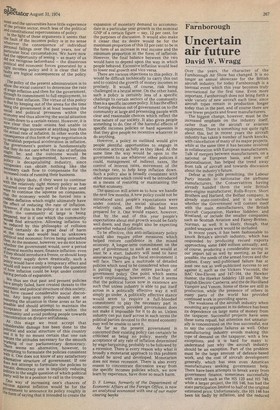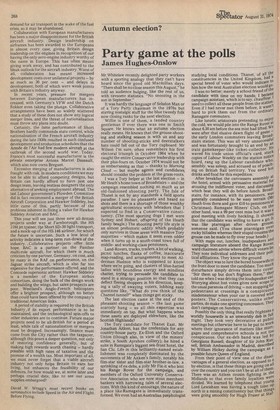Farnborough
Uncertain air future
David W. Wragg
Over the years, the character of the Farnborough Air Show has changed. It is no longer an annual showcase for the British aircraft industry, for today Farnborough is a biennial event which this year becomes truly international for the first time, Even more important, Farnborough does not bring forth a wide variety of new aircraft each time, since aircraft types remain in production longer today than in the past, and of course there are now tewer projects and fewer manufacturers. The biggest change, however, must be the increased emphasis on the industry itself, rather than on the aircraft or aviation equipment. There is something not quite right about this, but in recent years the aircraft industry has taken a number of harsh knocks, with cancellation of many of its major projects, while at the same time it has become involved in collaboration with European manufacturers.
Talk of mergers between manufacturers, on a national or European basis, and now of nationalisation, has helped the trend away from talk of aircraft and towards discussion about the industry's future. Defeat at the polls permitting, the Labour Party intends to nationalise the airframe manufacturers, the Conservatives having already handed them the sole British aero-engine manufacturer, Rolls-Royce. Short Brothers and Harland, the Belfast company, is already state-controlled, and it is unclear whether the Government will content itself with the main manufacturers, the British Aircraft Corporation, Hawker Siddeley, and Westland, or include the smaller companies, such as Scottish Aviation and Fairey-Britten-. Norman, as well. It is likely, though, that guided weapons work would be included. In recent years, it has been fashionable to knock Britain's aircraft industry, which has responded by producing record exports approaching some £400 million annually, and, of course, producing a considerable saving in our import bill as well by meeting, as far as possible, the needs of the armed forces and the airlines. Every well-publicised failure has at least one not so well-publicised success to set against it, such as the Vickers Viscount, the BAC One-Eleven and 147/164, the Hawker Hunter, the Hawker Siddeley 125 and 748, the English Electric Canberra, and the de Havilland Vampire and Venom. Some of these are still in production, while the presence of others in many parts of the world has provided continued work in providing spares. The weakness of the aircraft industry when mounting any argument in its defence has been its dependence on large sums of money from the taxpayer. Successful projects have seen these sums repaid, but attention not unnatur ally is concentrated on the less successful, not to say the complete failures as well. Other manufacturing industry avoids making this type of demand on the taxpayer, with a few exceptions, and it is hard for many tc understand just why the aircraft industry should be an exception. Part of the problem must be the large amount of defence-based work, and the cost of aircraft development generally, which has seen even American manufacturers seeking government help.
There have been attempts to break away from government finance, sometimes successfully with aircraft such as the HS 125 and HS 748, while a larger project, the HS 146, has had the state participation limited to half of the original estimated price. Unfortunately, the HS 146 has been hit badly by inflation, and the reduced demand for air transport in the wake of the fuel crisis, so it may be abandoned.
Collaboration with European manufacturers has been a major disappointment for the British aircraft industry. Design leadership on airframes has been awarded to the Europeans in almost every case, giving Britain design leadership on the engines in recognition of our having the only aero-engine industry worthy of the name in Europe. This has often meant giving work away, and has contributed to the bleak outlook for the aircraft industry. Worst of all, coilaboration has meant increased development costs over unilateral projects — by as much as 30 per cent — and delays in development; both of which were weak points . with Britain's industry anyway.
In recent years, pressure for mergers between European manufacturers has increased, with Germany's VFW and the Dutch Fokker even taking the plunge. Collaborative arrangements have been so widely scattered that a study of these does not show any logical merger lines, and the threat of nationalisation must throw any plans into doubt.
Certainly, the lame performance of Short Brothers hardly commends state control, while nationalisation of the French aircraft industry during the late 1930s resulted in such confused development and production schedules that the Armde de l'Air had few modern aircraft at the outbreak of the second world war. Today, France's most successful manufacturer is the private enterprise Avions Marcel Dassault, which also now owns Breguet.
Excessive merging of manufacturers is also fraught with risk. In modern conditions we may not be able to afford competing designs, but Britain can hardly afford to have just one design team, leaving restless designers the only alternative of seeking employment abroad. The last Labour government's Plowden Committee did in fact recommend a merger of the British Aircraft Corporation and Hawker Siddeley, but little came of this, partly because of the problems inherent in fixing a value for Hawker Siddeley Aviation and BAC.
This year will see just three new all-British projects under way at Farnborough, the HS 1184 jettrainer, tile Short SD-30 light transport, and a mock-up of the HS 146 airliner, for which the future is uncertain. Such a low level of activity indicates a long-term run-down of the industry. , Collaborative projects offer little hope. BAC is a partner on the Panther multi-role aircraft, for which there is much criticism by one partner, Germany, on cost, and by many in the RAF on performance, on the Jaguar strike aircraft, which is also far too expensive for the performance offered, and the Concorde supersonic airliner. Hawker Siddeley is a member of the European airbus consortium, doing the bulk of the design work and building the wings, but sales prospects are poor. Westland's Anglo-French helicopters offer a brighter prospect, although no better than could have been offered by the company's traditional American links.
A period of stability is required by the British industry / if its export performance is to be maintained, and the technological spin-offs to other industries are to continue. Future major projects need to be all-British for a period at least, while talk of nationalisation or mergers must be dropped. Increasingly, finance must come from the City rather than the taxpayer, although this poses a deeper question, not only of restoring confidence generally, but of making high rewards worth chasing — hardly possible with high rates of taxation and the promise of a wealth tax. Most important of all, we must never forget that a viable aircraft industry not only helps Britain to earn her living, but enhances the feasibility of our defences, for how would we, at some later and perhaps crucial date, like to see our arms supplies embargoed?
David W. Wragg's most recent books on aeronautics include Speed in the Air and Flight Before Flying.



































 Previous page
Previous page